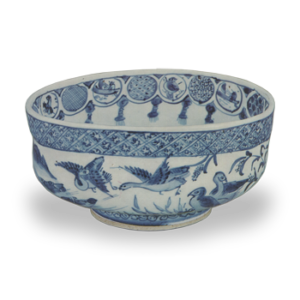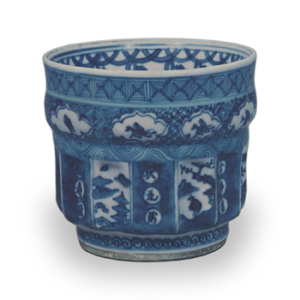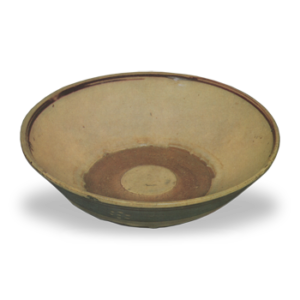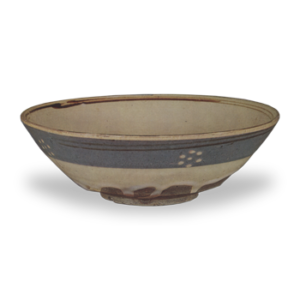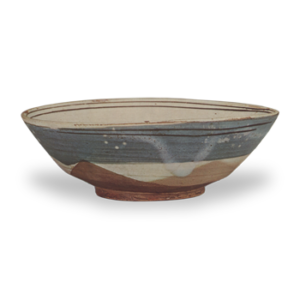A general term for the year of manufacture, the name of the user, the name of the maker, etc., on a piece of pottery. The negative characters are called “kanshi” and the positive characters are called “shiki. In China (see the section on “inscriptions” for Japanese inscriptions), it is said that pottery dating from the Song dynasty (960-1279) is rare, but there are some pieces with four characters from the Tang dynasty (713-1411), which were engraved on the original bronze ware when it was imitated in the Qing dynasty (1662-1722). This is a reproduction of the year engraved on the original bronze vessel when it was copied in the Kangxi period of the Qing dynasty (1662-1722), and is not a piece of pottery from the same period. The Yunryusai Seisyu (飲流斎説瓷), Ya (雅 (雅)), and other works mention that there are Song dynasty vessels with the two characters “neifu” on them, and that the calligraphy on some of them resembles that on Daguan coins, but the oldest known Yuan dynasty vessels are inscribed “neifu” and “kuyuanfu”. Some of the coins have inscriptions dated to the eleventh or eleventeenth year of the eleventh century, but the authenticity of these inscriptions is unknown. The “Jingdezhen Ceramic Record” (Jingdezhen Ceramic Record, vol. 5) states, “On the bottom of a piece fired during the Jingde period of the Song dynasty (100417), four characters are written that it was made in the Jingde year,” but the actual piece probably does not remain today. The oldest example of this type of vase that Ozaki Shinsheng saw was a celadon phoenix-ear vase with a seven-armed hand inscribed on the bottom in the year 1086193 of the Northern Song dynasty (960-1279), followed by a celadon phoenix-ear vase with a Junxi (117489) date on the bottom, also of the Southern Song dynasty. The Yuan dynasty was a time when the Guan kilns were used to produce pottery for the government. In the Yuan dynasty, the two characters “kurifu” were used on official wares, and few private wares had characters on the bottom of the vessels. Some vessels are engraved with floral motifs or wheel-thrown forms. After the Ming dynasty, the types of inscriptions were very varied. In general, official kilns are said to be marked with the year of manufacture within a double circle. Since each period has its own distinctive style and style of writing, it is believed that it is easy to recognize the style of a later imitation by the year, because it is extremely difficult to imitate it correctly, no matter how skillful the other aspects are. However, a general knowledge of the evolution of Chinese calligraphy in the past, and in particular, a good sense of discernment, is indispensable for this purpose. The different types of calligraphy can be distinguished in terms of characters, such as Chinese, Manchu, Western languages, Tibetan, Islamic languages, and so on. In terms of writing styles, there are seal script, standard script, and Song dynasty script, but there are few cursive or cursive scripts other than those used on miscellaneous vessels. There are several types of inscriptions, including seal, engraved, and blue-and-white, as well as one called “suiyaki inscription,” in which the inscription is burned on with colored enamel. The crescents are usually positioned on the vessel, but sometimes they are marked on the outer side of the mouth, as on some middle-grade wanryaku of the Ming dynasty (1573 – 1619). Some vessels with high legs are marked on the inside, while others are marked on the inside, and some, such as the Yongle pressure hand cup, are marked with a lion’s ball to be played with. Since the Kangxi period prohibited the writing of year markings for several decades, only a relatively small number of pieces with Kangxi year markings are known from the early and late periods. The number of pieces from the middle period of the Kangxi period, even those made in official kilns, do not bear a year’s signature. Some of them are decorated with patterns such as leaves. Those with the names of halls and study rooms in addition to the year were produced for private use by the imperial family, the imperial family of the day, wealthy officials, and wealthy people, and most of them are very beautiful. Most of them are exquisite. They include Ch’ien-lun-sai, Chung-wa-do, Jing-jing-yang-yang-hwa, Kei-shin-zhang, Shao-hon-do, Keia-wo-do, Sho-yi-sho-ya, Nei-jing-yin, Jin-deok-sheng, Shin-deok-sai, Uehon-do, and Yuko-do, to name but a few. The above is in accordance with Ozaki Shunsheng’s theory. In addition, the sixth chapter of “Yunryusai Seiryashi” describes in detail about the concept of “Janshiki”.
